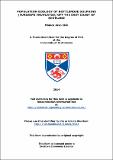Files in this item
Population ecology of bottlenose dolphins (Tursiops truncatus) off the east coast of Scotland
Item metadata
| dc.contributor.advisor | Hammond, Philip S. | |
| dc.contributor.author | Arso Civil, Mònica | |
| dc.coverage.spatial | 269 | en_US |
| dc.date.accessioned | 2015-04-22T15:43:51Z | |
| dc.date.available | 2015-04-22T15:43:51Z | |
| dc.date.issued | 2015-06 | |
| dc.identifier | uk.bl.ethos.644834 | |
| dc.identifier.uri | https://hdl.handle.net/10023/6543 | |
| dc.description.abstract | The population of bottlenose dolphins off the east coast of Scotland has been studied since the late 1980s, initially focused on the inner Moray Firth, where a Special Area of Conservation (SAC) was designated under the EU Habitats Directive. The population has since expanded its distributional range and currently ranges from the Moray Firth to the Firth of Forth. The main aims of this thesis were: (1) to estimate population parameters for this population using a 25 year individual recognition dataset, and (2) to increase knowledge of the distribution and abundance of dolphins in areas outside the SAC, especially to investigate areas of high use in St Andrews Bay. Apparent survival rate for adults and sub–adult dolphins was estimated at 0.946 (SE=0.005) accounting for temporary emigration caused by the population’s range expansion. Sex-specific survival was estimated for males (0.951, SE=0.013) and females (0.956, SE=0.011) using multistate models to minimize bias caused by individuals of unknown sex. Using a newly developed approach, fecundity rate was estimated at 0.222 (95% CI=0.218-0.253) from an expected mean inter-birth interval of 4.49 yrs (95% CI=3.94-4.93). Total population size was estimated as ~200 individuals, after accounting for temporary emigration and for heterogeneity in capture probabilities. In St Andrews Bay, an area used regularly in summer by approximately half the estimated population, habitat use modelling identified the entrance to the Firth of Tay and waters around Montrose as high use areas for dolphins, whose presence was influenced by tidal current speed and direction. The results suggest that the conservation and management plan for this small and isolated population of bottlenose dolphins should be reviewed to adapt it to current knowledge, especially regarding the uncertainty around the potential impacts of offshore renewable energy developments off the east coast of Scotland. | en_US |
| dc.language.iso | en | en_US |
| dc.publisher | University of St Andrews | |
| dc.rights | Creative Commons Attribution-NonCommercial-NoDerivatives 4.0 International | |
| dc.rights.uri | http://creativecommons.org/licenses/by-nc-nd/4.0/ | |
| dc.subject | Bottlenose dolphin | en_US |
| dc.subject | Population parameters | en_US |
| dc.subject | Mark-recapture | en_US |
| dc.subject | Habitat modelling | en_US |
| dc.subject | Conservation | en_US |
| dc.subject.lcc | QL737.C432A8 | |
| dc.subject.lcsh | Bottlenose dolphin--Scotland, East | en_US |
| dc.subject.lcsh | Cetacea populations--Scotland, East | en_US |
| dc.subject.lcsh | Bottlenose dolphin--Conservation--Scotland, East | en_US |
| dc.subject.lcsh | Bottlenose dolphin--Habitat--Scotland, East | en_US |
| dc.subject.lcsh | Population biology | en_US |
| dc.title | Population ecology of bottlenose dolphins (Tursiops truncatus) off the east coast of Scotland | en_US |
| dc.type | Thesis | en_US |
| dc.type.qualificationlevel | Doctoral | en_US |
| dc.type.qualificationname | PhD Doctor of Philosophy | en_US |
| dc.publisher.institution | The University of St Andrews | en_US |
This item appears in the following Collection(s)
Except where otherwise noted within the work, this item's licence for re-use is described as Creative Commons Attribution-NonCommercial-NoDerivatives 4.0 International
Items in the St Andrews Research Repository are protected by copyright, with all rights reserved, unless otherwise indicated.


